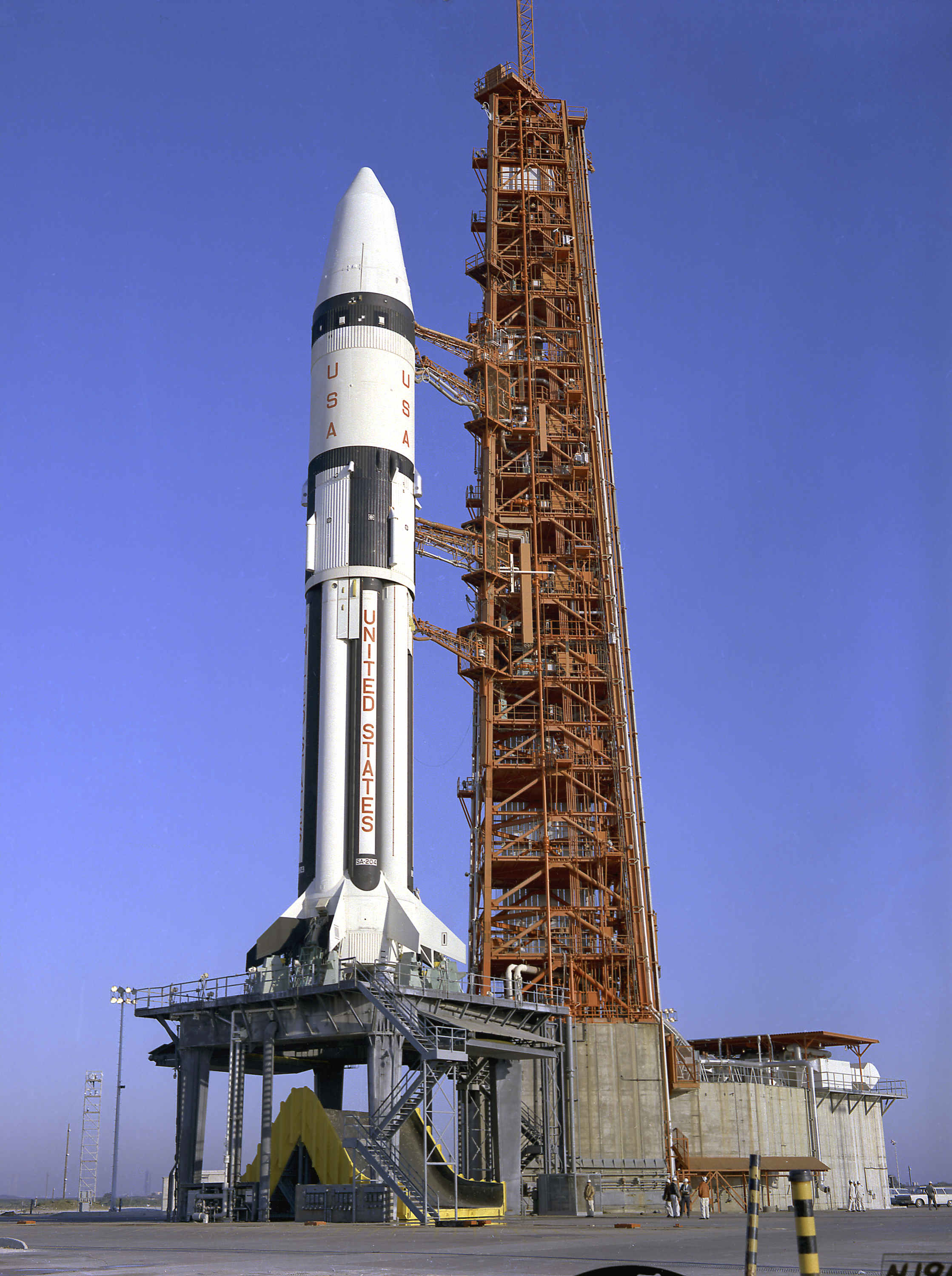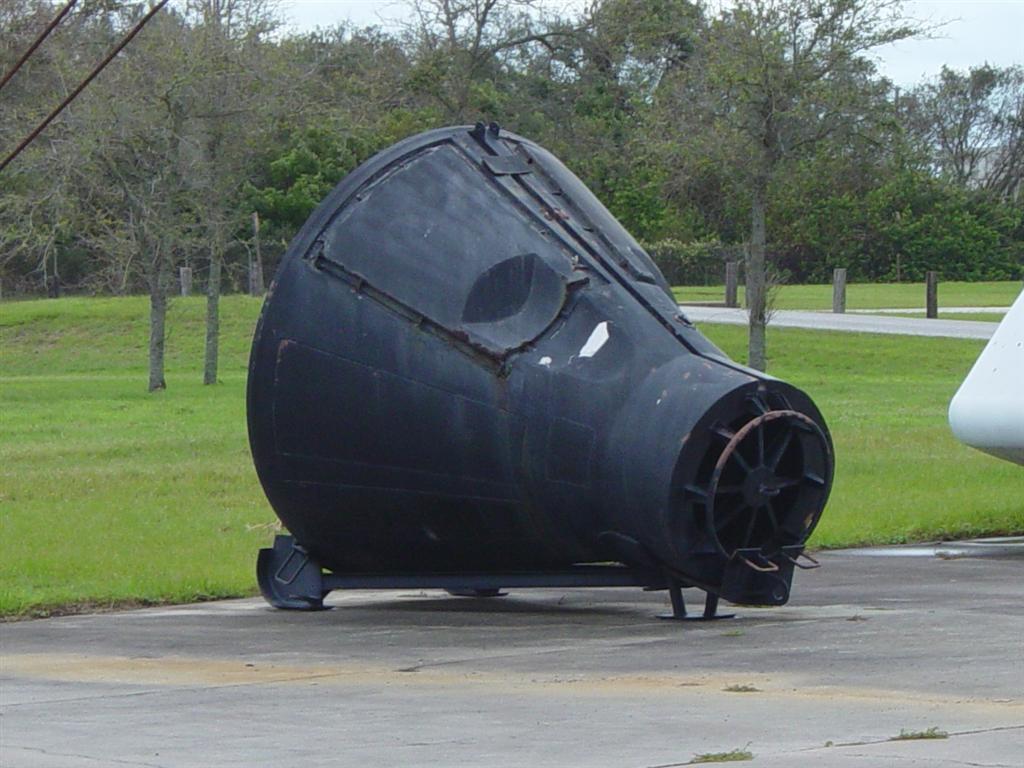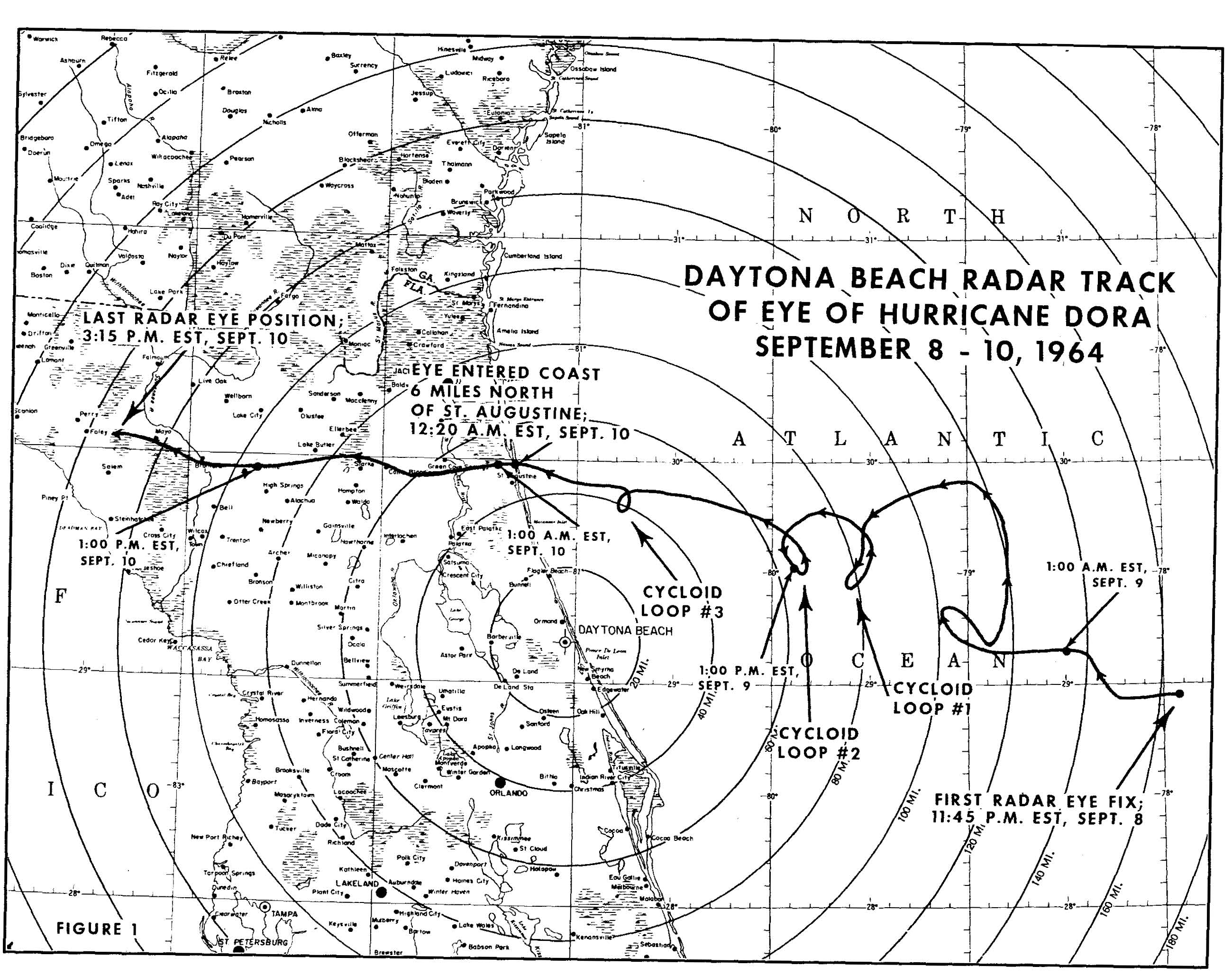|
AS-102
AS-102 (also designated SA-7) was the seventh flight of the Saturn I launch vehicle, which carried the boilerplate Apollo spacecraft BP-15 into low Earth orbit. The test took place on September 18, 1964, lasting for five orbits (about seven and a half hours). The spacecraft and its upper stage completed 59 orbits before reentering the atmosphere and crashing in the Indian Ocean on September 22, 1964. Objectives AS-102 was designed to repeat the flight of AS-101. It would once again carry a boilerplate Apollo command and service module. The only difference from Boilerplate 13 carried on AS-101 was that on Boilerplate 15, one of the simulated reaction control system thruster quads (attitude control thrusters) was instrumented to record launch temperatures and vibrations. Another major difference on AS-102 was that the launch escape system (LES) tower would be jettisoned using the launch escape and pitch control motors. AS-102 was the first time a Saturn rocket carried a programm ... [...More Info...] [...Related Items...] OR: [Wikipedia] [Google] [Baidu] |
AS-103
AS-103 was the third orbital flight test of a boilerplate Apollo spacecraft, and the first flight of a Pegasus micrometeroid detection satellite. Also known as ''SA-9'', it was the third operational launch of a two-stage Saturn I launch vehicle. Objectives Of 12 flight objectives assigned, two were concerned with the operation of the Pegasus satellite, eight with launch vehicle systems performance, one with jettisoning the launch escape system, and one with separation of the boilerplate spacecraft. The satellite objectives were (1) demonstration of the functional operations of the mechanical, structural, and electronic systems and (2) evaluation of meteoroid data sampling in near-Earth orbit. Since the launch trajectory was designed to insert the Pegasus satellite into the proper orbit, it differed substantially from the trajectory used in missions AS-101 and AS-102. Launch The launch vehicle consisted of an S-I first stage, an S-IV second stage, and an instrument unit. The ... [...More Info...] [...Related Items...] OR: [Wikipedia] [Google] [Baidu] |
AS-101
AS-101 (also designated SA-6) was the sixth flight of the Saturn I launch vehicle, which carried the first boilerplate Apollo spacecraft into low Earth orbit. The test took place on May 28, 1964, lasting for four orbits (about six hours). The spacecraft and its upper stage completed a total of 54 orbits before reentering the atmosphere and crashing in the Pacific Ocean on June 1, 1964. The flight experienced a single anomaly: one of the eight first-stage Saturn I engines shut down early, but the guidance system compensated by burning the remaining seven engines longer. AS-101 was followed by four more flights to verify the launch aerodynamics of the Apollo command and service module (CSM) and its launch escape system (LES) tower. Boilerplate Apollo The first five launches of the Saturn I had carried Jupiter nosecones, a proven design which allowed engineers to focus on development of the rocket. To verify the launch aerodynamics of the CSM, AS-101 carried BP-13, a boilerplat ... [...More Info...] [...Related Items...] OR: [Wikipedia] [Google] [Baidu] |
Saturn I
The Saturn I was a rocket designed as the United States' first medium lift launch vehicle for up to low Earth orbit payloads.Terminology has changed since the 1960s; back then, 20,000 pounds was considered "heavy lift". The rocket's first stage was built as a cluster of propellant tanks engineered from older rocket tank designs, leading critics to jokingly refer to it as "Cluster's Last Stand". Its development was taken over from the Advanced Research Projects Agency in 1958 by the newly formed civilian NASA. Its design proved sound and flexible. It was successful in initiating the development of liquid hydrogen-fueled rocket propulsion, launching the Pegasus satellites, and flight verification of the Apollo command and service module launch phase aerodynamics. Ten Saturn I rockets were flown before it was replaced by the heavy lift derivative Saturn IB, which used a larger, higher total impulse second stage and an improved guidance and control system. It also led the ... [...More Info...] [...Related Items...] OR: [Wikipedia] [Google] [Baidu] |
Cape Canaveral Air Force Station Space Launch Complex 37
Space Launch Complex 37 (SLC-37), previously Launch Complex 37 (LC-37), is a launch complex on Cape Canaveral Space Force Station, Florida. Construction began in 1959 and the site was accepted by NASA to support the Saturn I program in 1963. The complex consists of two launch pads. LC-37A has never been used, but LC-37B launched uncrewed Saturn I flights (1964 to 1965) and was modified and launched Saturn IB flights (1966 to 1968), including the first (uncrewed) test of the Apollo Lunar Module in space (Apollo 5). It was deactivated in 1972. In 2001 it was modified as the launch site for Delta IV, a launch system operated by United Launch Alliance. The original layout of the launch complex featured one Mobile Service Structure which could be used to service or mate a rocket on either LC-37A or 37B, but not on both simultaneously. The Delta IV Mobile Service Tower is tall, and fitted to service all Delta IV configurations, including the Delta IV Heavy. Launch history Rocket con ... [...More Info...] [...Related Items...] OR: [Wikipedia] [Google] [Baidu] |
Boilerplate (spaceflight)
A boilerplate spacecraft, also known as a mass simulator, is a nonfunctional craft or payload that is used to test various configurations and basic size, load, and handling characteristics of rocket launch vehicles. It is far less expensive to build multiple, full-scale, non-functional boilerplate spacecraft than it is to develop the full system (design, test, redesign, and launch). In this way, boilerplate spacecraft allow components and aspects of cutting-edge aerospace projects to be tested while detailed contracts for the final project are being negotiated. These tests may be used to develop procedures for mating a spacecraft to its launch vehicle, emergency access and egress, maintenance support activities, and various transportation processes. Boilerplate spacecraft are most commonly used to test crewed spacecraft; for example, in the early 1960s, NASA performed many tests using boilerplate Apollo spacecraft atop Saturn I rockets, and Mercury spacecraft atop Atlas roc ... [...More Info...] [...Related Items...] OR: [Wikipedia] [Google] [Baidu] |
NASA
The National Aeronautics and Space Administration (NASA ) is an independent agency of the US federal government responsible for the civil space program, aeronautics research, and space research. NASA was established in 1958, succeeding the National Advisory Committee for Aeronautics (NACA), to give the U.S. space development effort a distinctly civilian orientation, emphasizing peaceful applications in space science. NASA has since led most American space exploration, including Project Mercury, Project Gemini, the 1968-1972 Apollo Moon landing missions, the Skylab space station, and the Space Shuttle. NASA supports the International Space Station and oversees the development of the Orion spacecraft and the Space Launch System for the crewed lunar Artemis program, Commercial Crew spacecraft, and the planned Lunar Gateway space station. The agency is also responsible for the Launch Services Program, which provides oversight of launch operations and countdown m ... [...More Info...] [...Related Items...] OR: [Wikipedia] [Google] [Baidu] |
Hurricane Cleo
Hurricane Cleo was the strongest tropical cyclone of the 1964 Atlantic hurricane season. It was the third named storm, first hurricane, and first major hurricane of the season. Cleo was one of the longest-lived storms of the season. This compact yet powerful hurricane travelled through the Caribbean Sea and later hit Florida before moving offshore Georgia into the Carolinas, killing 156 people and causing roughly $187 million in damage. Major damage was seen as far north as east-central Florida, with the heaviest rains falling along the immediate coast of the Southeast United States into southeast Virginia. Meteorological history A tropical wave that exited the coast of Africa on August 15, 1964, moved westward, not organizing into a tropical depression until around 890 miles (1432.3 km) east of Barbados on August 20–as reported by a Navy reconnaissance plane. It continued west-northwestward, quickly strengthening to a hurricane the next day with a minimu ... [...More Info...] [...Related Items...] OR: [Wikipedia] [Google] [Baidu] |
Spacecraft Which Reentered In 1964
A spacecraft is a vehicle or machine designed to fly in outer space. A type of artificial satellite, spacecraft are used for a variety of purposes, including communications, Earth observation, meteorology, navigation, space colonization, planetary exploration, and transportation of humans and cargo. All spacecraft except single-stage-to-orbit vehicles cannot get into space on their own, and require a launch vehicle (carrier rocket). On a sub-orbital spaceflight, a space vehicle enters space and then returns to the surface without having gained sufficient energy or velocity to make a full Earth orbit. For orbital spaceflights, spacecraft enter closed orbits around the Earth or around other celestial bodies. Spacecraft used for human spaceflight carry people on board as crew or passengers from start or on orbit (space stations) only, whereas those used for robotic space missions operate either autonomously or telerobotically. Robotic spacecraft used to support scientific re ... [...More Info...] [...Related Items...] OR: [Wikipedia] [Google] [Baidu] |
A-002
A-002 was the third abort test of the Apollo spacecraft. Objectives Mission A-002 was the third in the series of abort tests to demonstrate that the launch system would perform satisfactorily under selected critical abort conditions. The main objective of this mission was to demonstrate the abort capability of the launch escape vehicle in the maximum dynamic pressure region of the Saturn trajectory with conditions approximating the altitude limit at which the Saturn emergency detection system would signal an abort. The launch vehicle was the third in the Little Joe II series. This vehicle differed from the previous two in that flight controls and instrumentation were incorporated, and the vehicle was powered by two Algol and four Recruit rocket motors. The launch escape system was also changed from previous configurations in that canards (forward control surfaces used to orient and stabilize the escape vehicle in the entry attitude) and a command module boost protective cover w ... [...More Info...] [...Related Items...] OR: [Wikipedia] [Google] [Baidu] |
Barnacle
A barnacle is a type of arthropod constituting the subclass Cirripedia in the subphylum Crustacea, and is hence related to crabs and lobsters. Barnacles are exclusively marine, and tend to live in shallow and tidal waters, typically in erosive settings. They are sessile (nonmobile) and most are suspension feeders, but those in infraclass Rhizocephala are highly specialized parasites on crustaceans. They have four nektonic (active swimming) larval stages. Around 1,000 barnacle species are currently known. The name is Latin, meaning "curl-footed". The study of barnacles is called cirripedology. Description Barnacles are encrusters, attaching themselves temporarily to a hard substrate or a symbiont such as a whale (whale barnacles), a sea snake ('' Platylepas ophiophila''), or another crustacean, like a crab or a lobster ( Rhizocephala). The most common among them, "acorn barnacles" ( Sessilia), are sessile where they grow their shells directly onto the substrate. Peduncul ... [...More Info...] [...Related Items...] OR: [Wikipedia] [Google] [Baidu] |
1964 Atlantic Hurricane Season
The 1964 Atlantic hurricane season featured the highest number of U.S.- landfalling hurricanes since 1933. The season officially began on June 15, and lasted until November 30. These dates conventionally delimit the period of each year when most tropical cyclones form in the Atlantic basin. The season was above average, with thirteen named storms, seven hurricanes, and five major hurricanes. The first system, an unnamed tropical storm, developed on June 2, almost two weeks before the official start of the season. Striking Florida on June 6, the storm brought localized flooding to portions of Cuba and the Southeastern United States, leaving about $1 million in damage. The next storm, also unnamed, developed near the end of July; it did not impact land. The effects of Hurricanes Cleo, Dora, and Isbell combined were devastating to Florida. Cleo also brought destruction to portions of the Caribbean, especially Guadeloupe and Haiti. After moving inland, Cle ... [...More Info...] [...Related Items...] OR: [Wikipedia] [Google] [Baidu] |








